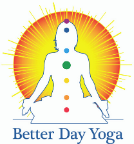
Last week found me at the Grand Tetons for the first time. Anyone who’s witnessed this awesome gift of nature will know why they inspired me to focus on mountain pose this month. I have never felt more grounded than while viewing this breathtaking landscape.
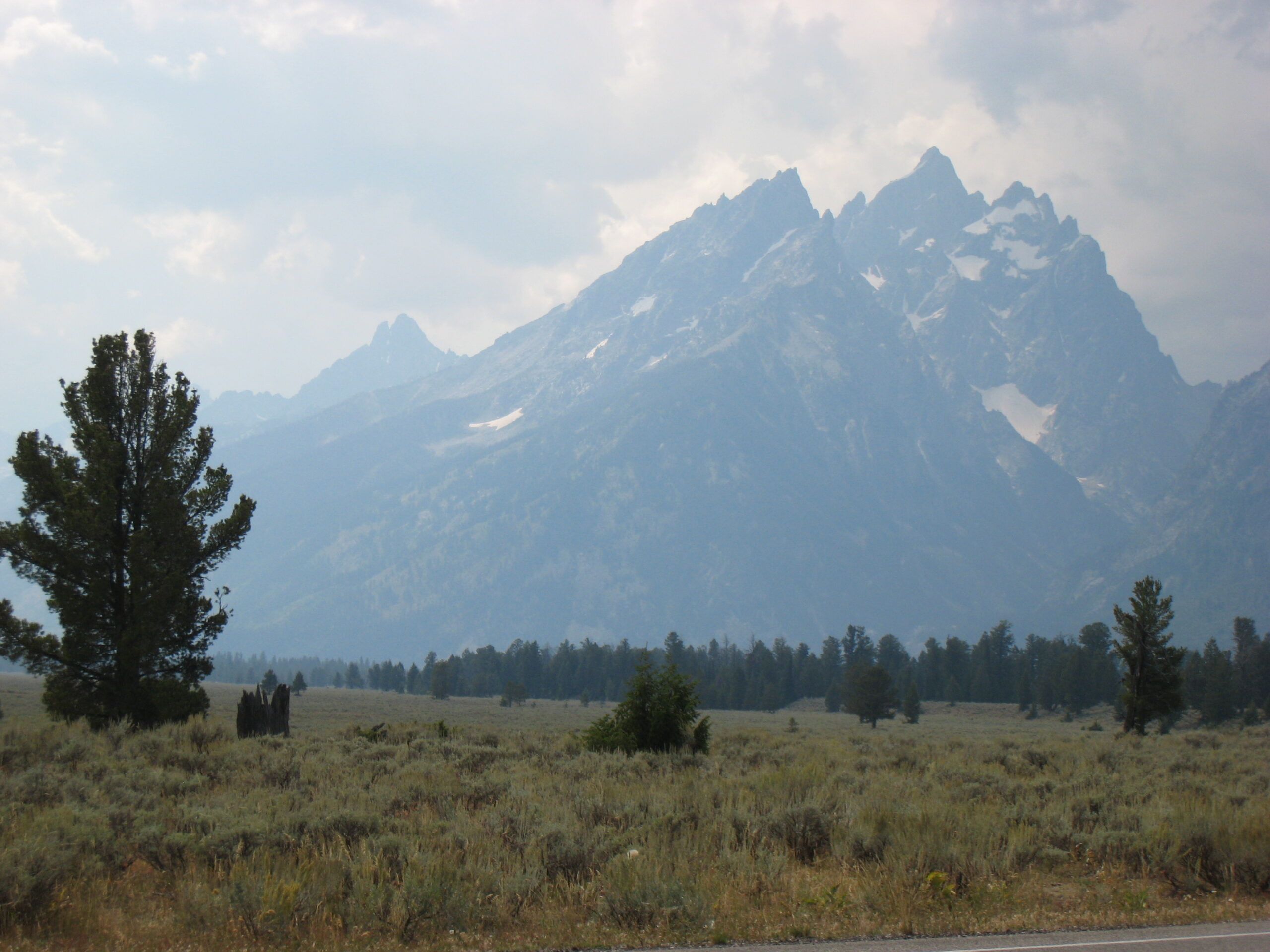
Just as you can use mountain pose as your “go to” pose for grounding in your everyday life, mountain pose is the template for alignment of all the other poses.
Benefits:
- Strengthens body/mind connection.
- Improves posture
- Strengthens thighs, knees, ankles
- Firms abs and glutes
- Can relieve sciatica
- Reduces flat feet
Alignment Cues: Stand at the top of your mat, feet hip distance apart and parallel to the edges of the mat if you’re a beginner, or toes touching for mind/body connection—heels out. Pressing down through the feet, raise the inner arches, lift knee caps, raise the inner thighs (all same cues). Inward spiral the inner thighs—or use a block or ball between the thighs as a prop to facilitate that feeling. Relax the shoulders down away from the ears and roll the shoulders back so the shoulder blades reach toward each other and rest on the back. Keep the ribs tucked in, containing your power. (The Solar Plexus area is the home of the third chakra, our willpower and our “sense of self”.) Roll the tailbone down toward the floor while simultaneously reaching the pubic bone toward the tail bone creating space in both the front and back sides of the body.
Hands can be resting at your sides, palms out,
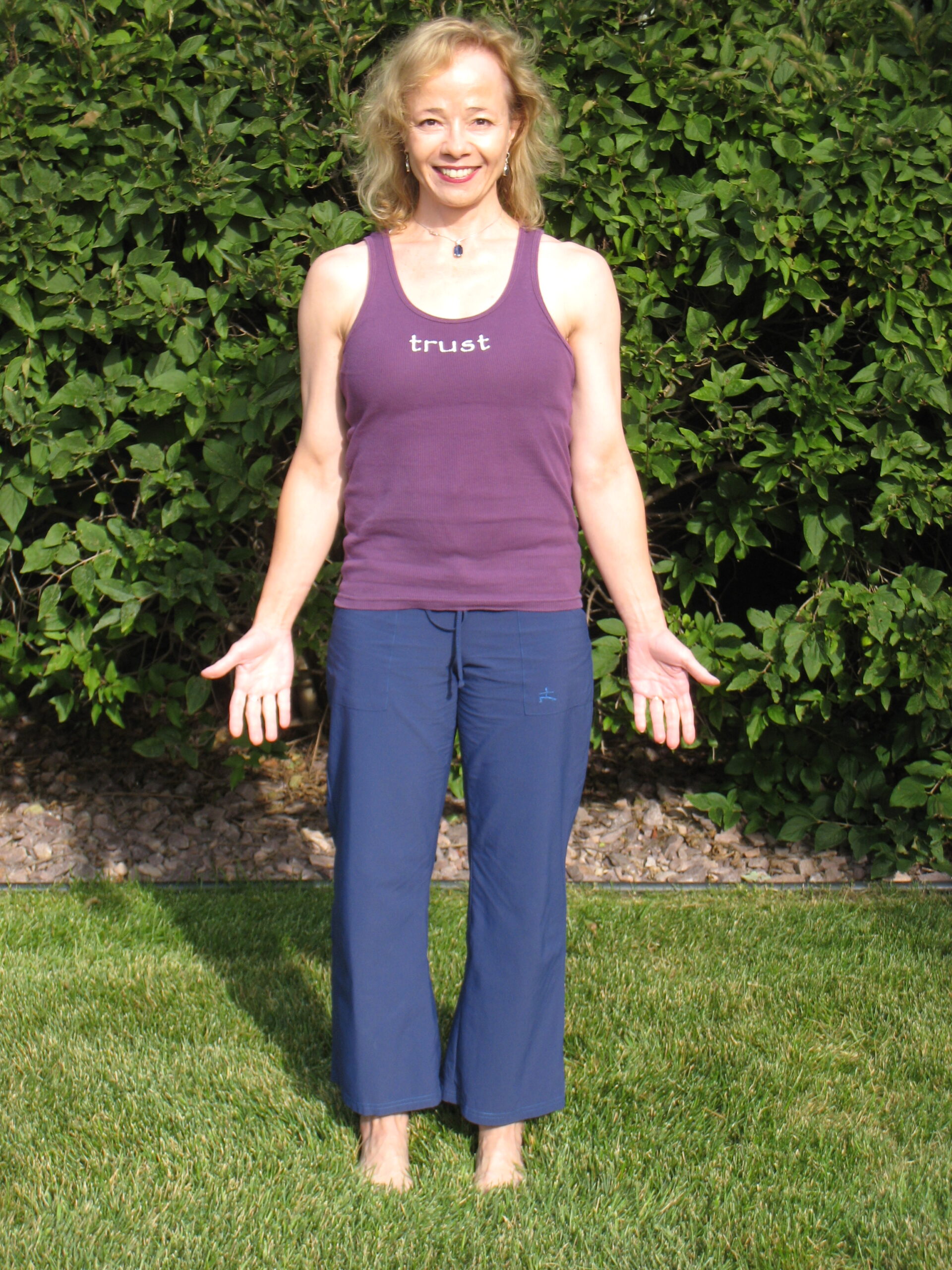
or held in prayer/Namaste position see below for more on prayer/Namaste position).

There are several arm positions for mountain pose. Shiva Rea introduced me to what I like to refer to as “Charlie’s Angel’s” hand position, or “steeple hands”
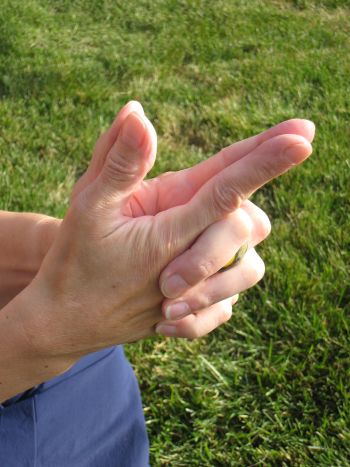
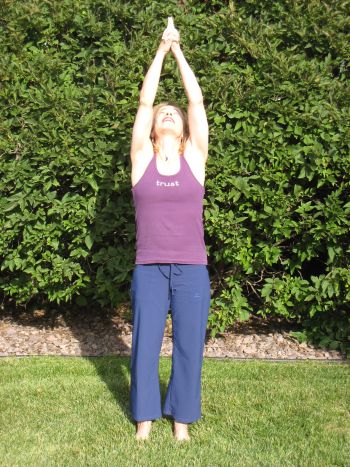
You can also try yoga mudra arms , or
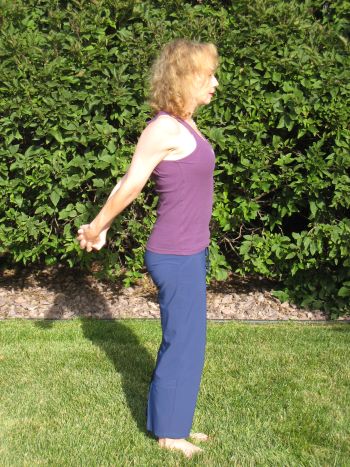
interlaced fingers with palms up to the sky for a nice stretch.

Other options not shown would be to grasp opposite elbows behind the back for another heart opener. The possibilities are endless! Have fun with it! Adding a block or yoga ball between the thighs just above the knees a couple inches (also not shown) is an excellent way to facilitate the inward spiral of the thighs and promote more grounding, activating the root chakra.
“Some people approach their yoga practice as a break from the world, a separate space where they can recover from life’s stresses and strains. Once they’ve pulled themselves back together, they return to their families and jobs renewed. What we really want to learn is how to incorporate our yoga practice into the rest of our lives and to respond appropriately to life’s challenges without adding tension. It is at this level that yoga really becomes a deeper practice. You can be under tremendous stress and come back into experiencing your feet on the ground as though it were just another moment of Tadasana (Mountain Pose); or you can receive a big disappointment and be able to drop into your breath, realizing it’s just another moment of practice, and allow the breath to move the feelings through your body.” Yoga Journal
Beginner’s tip: You can check your alignment by placing your back against the wall. Stand with the backs of your heels, sacrum, and shoulder blades touching the wall. Apply the alignment cues. You shouldn’t be able to get your fist behind your back—Fun to try to do before and after the alignment cues.
Option to close your eyes to focus inward, build balance and breathe.
Let’s focus on Foot Yoga:
The base of any yoga pose is essential. The feet are the foundation for mountain pose. I am a firm believer that the health of our feet predicts the health of the entire body:
“Each foot has 26 bones, 33 joints, 19 muscles, and 107 ligaments. Virtually supporting the entire body, feet tend to hold or reflect the state of your mind and heart. If you don’t believe me, consider the seemingly endless foot metaphors to describe our moods and inclinations: When decisive, self confident, flexible, and on the move, we’re fleet of foot or quick on our feet. When immobilized, weak or wishy-washy, we have feet of clay or are dragging our feet. We get a foot up on our business competitors, and our dogs howl after a long day of rushing around. So put your best foot forward and consider the following ways to nurture your feet:
Exercise is essential for maintaining the mobility and flexibility of your feet. Foot exercises may also relieve soreness. Naturally, see a podiatrist where warranted. Here are a few exercises that can be done anytime:
- Rock back and forth from your heels to toes for several minutes.
- Stand in yoga’s Tadasana or mountain pose often for its foot rejuvenating benefits. Lift your toes and spread open wide before planting into the earth. Also, there are now yoga sandals that have spacers that separate each toe. They’re awesome!” http://www.organicspamagazine.com/index.php/articles/category/beauty-and-style/conscious-care-for-your-feet/
Let’s focus on the benefits of good posture:
Posture: Why is good posture so important? It’s pretty simple. When the spine is properly aligned with its natural curvature and the entire body – from the ears to the shoulders to the hips, knees and down to the ankles and feet – is in balance, we maximize spine health and avoid poor posture-related pain and dysfunction. Ideal posture creates ideal balance; it also optimizes breathing and circulation. And shouldn’t we all want to achieve that?
Get out of your slumped, bent-back, round-shoulders position that is likely all too common if you work at a computer, spend considerable time texting or checking e-mail on your cell phone (who doesn’t these days?), or engage in any of the countless activities that put your back, neck and spine at risk courtesy of poor posture. It’s time to stand tall, walk tall and improve your spinal health, all at the same time! Are you and your family ready to perfect your posture?
Possible Spiritual aspects of mountain pose:
- “Let’s talk about mountains: You start climbing one, you toil, you sweat, and finally you reach the top—and what do you get? Well along with a sense of accomplishment and peace, you get a great view of the next mountain—looming, challenging, calling your name. Enjoy the current view, and be for now, for you. Then when you’re ready, put on your backpack and start back down the mountain, one step at a time—since that’s all you can do. This walk never ends, you know. There’s always another mountain. That’s what makes life so thrilling and you breathless.
There are days, there are times when you feel like you walked so far, when the voice inside you is complaining that it’s all uphill, that it always will be. And then, after all that, way beyond your blue horizon you see the biggest mountains you’ve ever climbed and you think..”I can’t do that.” Well I hope you always have somebody who tells you that you can, like I’m telling you now.” (I Hope you Dance Journal by Mark D. Sanders & Tia Sillers).
- Pavarati is the Hindu Goddess of the mountains who just happens to be the mother of Ganesh—remover of obstacles. As in many religions, and life, the way to the son is through the mother. So evoke Pavarati in Mountain Pose to create positive changes in your life—perhaps by removing any perceived obstacles.
- Namaste prayer pose: Calling the unknown—The Power of Prayer:
Humans share many things, including the urge to call on something greater than ourselves. We may invoke the heavens through astrology, meditation, the arts or science to understand our relationship with the Cosmos. That is why prayer is so powerful…we are looking to tap into the Unknown for guidance, for answers to Life’s difficult questions.
Yogis understood the technology of prayer. You press together the left palm (the negative current) and the right palm (positive current) at the heart center (sternum/mind nerve), into what is known as prayer pose, to calm the thoughts. From this place of neutrality and inner peace you are in a position to tune into the voice of your inner wisdom. We are all part of the Cosmos—a holographic “chip” off the Universal Computer. So prayer makes perfect sense. It guides you into a calm, peaceful place from which you can listen with your heart. (From Yogamint’s website which is no longer active.)
Contraindicated for:
- Headache
- Insomnia
- Low blood pressure
(Source for contraindications: http://www.yogajournal.com/poses/492)
